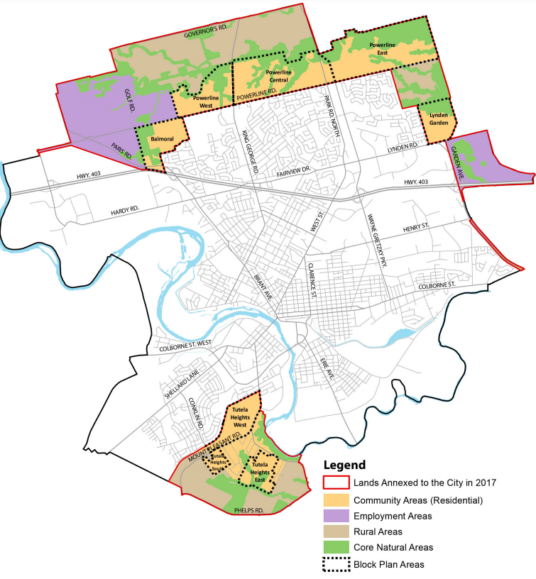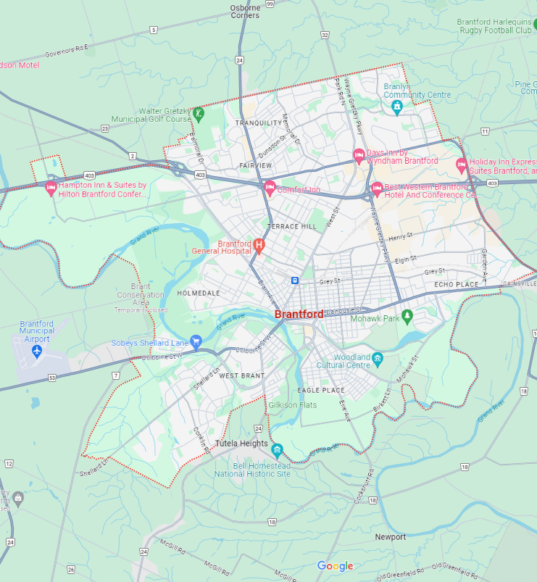The selection of data providers and navigational aids can have a big influence on strategic decision-making in today’s data-driven business environment. With a case study on the annexation of the City of Brantford, we’ll discuss the subtle distinctions between Google Maps and government maps and go into detail on how businesses can evaluate data sources critically.
Government Maps vs. Google Maps
Our everyday lives revolve around digital mapping and it is important to know the differences between the many kinds of mapping services, particularly for professionals and enterprises that depend on geographic data. This is where the distinction between Government and Google Maps becomes most important. Government maps are reliable resources for legal, geographic, and urban planning issues. They are frequently the result of thorough surveys and official records. Conversely, Google Maps, a mainstay of contemporary online mapping, has wide coverage, intuitive features, and real-time traffic updates, making it an invaluable tool for daily use and navigation.
But every kind of map has a different function and has advantages and disadvantages of its own. For example, although official maps are highly regarded for their precision in legal and topographical features, they might not offer the same instantaneous updates and accessibility as Google Maps. On the other hand, even though Google Maps is very popular and convenient, it might not always match up exactly with official data, especially in places that are changing quickly.
This brings us to an examination of the differences between these two mapping sources. We’ll consider a variety of factors, including source accuracy, update frequency, scale and detail, and legal authority, to give you a thorough understanding of when and why one might be better suited than the other in various situations, as demonstrated by examples like the 2017 annexation of the City of Brantford.
- Source and Accuracy:
- Government Maps: These are often created from data collected by government agencies, which might include geological surveys, satellite imagery, and other official sources. They are generally very accurate for legal, cadastral (related to land ownership), and topographical details. They might be more reliable for official uses like planning and development.
- Google Maps: Google sources its data from a combination of satellite imagery, street view, third-party data providers, and user-generated content. It is frequently updated and highly accurate for navigation and everyday use but might not always align perfectly with official records, especially in rapidly changing areas or rural and remote locations.
- Purpose and Usage:
- Government Maps: Typically used for official purposes, such as urban planning, land administration, environmental monitoring, and legal documentation. They often have a higher level of detail regarding zoning, land parcels, and geographic features.
- Google Maps: Primarily designed for public consumer-level use, focusing on navigation, business listings, traffic conditions, and points of interest. It is user-friendly and widely accessible on various devices.
- Update Frequency:
- Government Maps: Updating these maps can be a lengthy process due to the formal procedures involved. They may not reflect recent changes in infrastructure or newly developed areas as quickly.
- Google Maps: Updated more frequently and incorporates real-time traffic data, which makes it highly responsive to recent changes in road networks, new constructions, and businesses.
- Detail and Scale:
- Government Maps: Often have more detailed scales and can provide in-depth topographical data, property boundaries, and other specific information.
- Google Maps: While detailed, it might not always have the specific scale or level of detail that government maps provide, especially regarding legal boundaries.
- Legal Authority:
- Government Maps: Have legal authority and are used in official contexts. For instance, property disputes would rely on government maps rather than commercial maps.
- Google Maps: This does not have legal authority and should not be used for legal, land dispute, or detailed planning purposes.
- Accessibility:
- Government Maps: They may not always be readily accessible to the public or might require special permissions or fees to access.
- Google Maps: Highly accessible to anyone with internet access, and easy to use.
- Customization and Features:
- Government Maps: Less likely to have user-friendly features such as real-time traffic updates, business reviews, or routing options.
- Google Maps: Offers various features such as street view, real-time traffic updates, route planning, and business reviews.
Regarding who is “right” will depend on the context. For legal, geographical, and official uses, government maps are typically the authoritative source. Google Maps is highly reliable and more user-friendly for everyday navigation and general information. Each serves different purposes and choosing the right one depends on the specific requirements of the task at hand.
Case Study – City of Brantford Boundary Changes
The City of Brantford, in 2017 annexed 2720 hectares of land from the County of Brant, with boundaries expanding for residential, employment, and community purposes. As of 2024, these changes of nearly seven years have not been reflected in Google Maps. It highlights the lag in Google Maps’ reflection of such changes, demonstrating the need for understanding the strengths and limitations of different map types. These changes can be tracked across Canada at this Statistics Canada site.
Evaluating Data Providers for Your Business
In today’s landscape where data is frequently compared to the new oil, businesses worldwide are becoming more dependent on external data to inform their decisions, strategies, and innovations. Because of this dependence, choosing and assessing the best data source is not only a standard administrative chore but also a crucial business choice with potentially significant ramifications. As a competitive edge, new insights and future trends can all be revealed by the proper data provider. On the other hand, inaccurate or unnecessary data might result in poor judgment calls and lost opportunities.
Several important considerations must be made before a business enters this crucial selection phase. Each component is essential in guaranteeing that the data is in line with certain goals and demands, from timeliness and accuracy to relevance and legal compliance. This paves the way for a more thorough examination of the qualities that companies ought to demand from a data supplier, to arm decision-makers with the information they need to make wise decisions when seeking out high-quality data.
- Data Quality and Accuracy
- Any organization using data-driven initiatives must guarantee data quality and accuracy. When data is Accurate, it depicts the real-world conditions that it is intended to. Having all the information required to create a thorough illustration is referred to as Completeness. Having up-to-date information and making sure decisions are founded on the most recent data are key components of Timeliness. Data Consistency between different datasets is essential for accurate comparison and analysis.
- Relevance to Business Needs
- Data must be closely aligned with specific business goals, industry requirements, and market dynamics. It should directly support the decision-making process, strategic planning, and operational efficiency. Data that is irrelevant, even if high-quality, can lead to misguided strategies and wasted resources.
- Data Granularity
- The granularity of data refers to the level of detail. While high granularity can offer more precise insights and enable deeper analysis, it can also introduce complexity and irrelevant information. The key is to find the right balance that matches the business’s analytical capabilities and needs.
- Consistency and Standardization
- Consistency in data formats, units of measurement, and definitions across different sources is vital for effective data integration and comparison. Standardization simplifies data processing and analysis, especially when dealing with multiple data sources.
- Ensuring that the data is in a format that is compatible with existing systems and software is key for efficient integration. Incompatibility can lead to additional costs and time spent on data conversion or system upgrades.
- Data Governance and Compliance
- Compliance with legal standards such as PIPEDA, GLBA, GDPR, and HIPAA is critical. This compliance ensures ethical data usage, protects consumer rights, and prevents legal complications. Businesses must understand these regulations and ensure their data sources are compliant.
- Cost and Licensing
- The financial aspect of acquiring data involves not just the initial cost but also understanding the licensing terms, ongoing fees, and usage restrictions. Businesses must evaluate whether the cost aligns with the expected value and fits within their budget constraints.
- Technical Support and SLAs
- The level of technical support, including responsiveness and expertise is crucial, especially in situations where data is integral to daily operations. Service Level Agreements (SLAs) should clearly define support terms, availability, and response times.
- Scalability and Futureproofing
- The ability of data sources to scale according to business growth and adapt to future changes in technology and data analytics methodologies is crucial for long-term data strategy. For example the access from local to provincial and national level data.
- Customization and Flexibility
- Data providers offering customization options enable businesses to tailor data solutions to their specific needs, which can be a significant advantage in achieving targeted insights and outcomes.
- Sample Data and Trials
- Accessing sample data or trial periods allows businesses to test the data’s relevance, quality, and compatibility with their systems before making a commitment, reducing the risk of investing in unsuitable data sources.
- User Reviews and Testimonials
- Reviews and testimonials from other users can provide valuable insights into the practical applications and reliability of the data. This feedback can help make an informed decision about the data provider.
- Data Variety
- Having access to a variety of data types — such as structured, unstructured, real-time, and historical data — enables businesses to address a wide range of questions and use cases.

Selecting the right data provider and understanding the specific uses of different map types are crucial for informed business decision-making. It is important to consider both technical and practical aspects in these choices to ensure that businesses are equipped with accurate, relevant, and actionable information.
Are you facing data challenges in your industry? Read our other blogs to explore more topics and reach out to our experts for guidance and solutions tailored to your specific needs. Our Manifold Data Products and Polaris Intelligence Platform are comprehensive and up to date with the latest industry changes.


